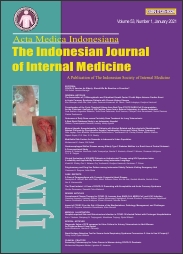Clinical Evaluation of HIV/AIDS Patients on Antiretroviral Therapy using HIV Symptoms Index: A reliability and Applicability Evaluation using Indonesian Language
Keywords:
symptom, HIV/AIDS, clinical evaluationAbstract
Background: HIV/AIDS is a chronic, lifelong disease with a wide clinical spectrum which could decrease the quality of life. Objective symptoms measurement is important because it is correlated to treatment adherence and progressivity of the disease. Currently, there is no clinical tool available to evaluate symptoms of HIV infection and the treatment’s side effect for the outpatient setting. This study aimed is to assess the reliability of the Indonesian version of HIV Symptom Index for measuring symptoms of HIV/AIDS patients, and use it for assessment of their symptom profile. Methods: this is a cross sectional study in outpatient HIV/AIDS subjects (n=87) recruited in Cipto Mangunkusumo Hospital’s HIV clinic from September-November 2018. The HIV Symptom Index consisted of 20 items evaluating somatic, psychologic, and the combination of both symptoms, and its’ language adaptation to Indonesian was done with Beaton and Guillemin method. Reliability of the Indonesian version of HIV Symptom Index was tested by alpha cronbach’s a coefficient analysis, and the internal validity was tested with multitrait scaling analysis before being used to profile the symptom pattern of HIV/AIDS patients. Results: Indonesian version of HIV Symptom Index is reliable (cronbach alpha 0.76) and valid (multitrait correlation >0.4) for measuring symptoms of HIV/AIDS patients. The most common symptom is fatigue (55.7%), followed by insomnia (43.3%), dizziness and lightheadedness (42.3%), skin problems (42.3%), and pain, numbness, or tingling in the hands or feet (39.2%). Conclusion: Indonesian version of HIV symptom Index is reliable and valid to measure symptoms of HIV/AIDS patiens objectively.References
Ortblad KF, Lozano R, Murray CJL. The burden of HIV: Insights from the global burden of disease study 2010. AIDS. 2013;27(13):2003–17.
WHO 2014. WHO - The top 10 causes of death . Fact sheet N°310 (Updated May 2014). 2014. Available on: http://www.who.int/mediacentre/factsheets/ fs310/en/ pada 10 Oktober 2017.
World Health Organization. Prevalence of HIV among adults aged 15-49 (%). 2013. Available on: http://www.who.int/gho/hiv/epidemic_status/ prevalence/en/ pada 10 Oktober 2017.
UNAIDS. Global AIDS Update 2016. World Health Organization . 2016; March:422. Available on: http://www.unaids.org/sites/default/files/ media_asset/UNAIDS_Gap_report_en.pdf pada 15 Oktober 2017
Justice AC, Holmes W, Gifford AL, et al. Development and validation of a self-completed HIV symptom index. J Clin Epidemiol. 2001;54-12.1.
Whalen CC, Antani M, Carey J, Landefeld CS. An index of symptoms for infection with human immunodeficiency virus: reliability and validity. J Clin Epidemiol. 1994;47(5):537–46.
Justice AC, Chang CH, Rabeneck L, Zackin R. Clinical importance of provider-reported HIV symptoms compared with patient-report. Med Care. 2001;39(4):397–408.
Justice AC, Rabeneck L, Hays RD, Wu AW, Bozzette SA, Group OC of the ACT. Sensitivity, specificity, reliability, and clinical validity of provider-reported symptoms: a comparison with self-reported symptoms. J Acquir Immune Defic Syndr. 1999;21: p. 126–33.
Sastroasmoro S, Ismael S. Dasar-dasar metodologi penelitian klinis. Jakarta: Sagung Seto; 2011. p. 25–32.
Muhammad NN, Shatri H, Djoerban Z, Abdullah M. Validity and reability test of indonesian version of world health the quality of life patients with HIV/ AIDS Uji Kesahihan dan Keandalan Kuesioner World Health Organization Quality of Life-HIV Bref dalam Bahasa Indonesia untuk Mengukur Kualitas Hidup Pa. J Penyakit Dalam Indones. 2017;4(3):112–8.
Ditjen P2P Kementrian Kesehatan RI. Laporan situasi perkembangan HIV-AIDS dan PIMS di indonesia 2018. Jakarta: Dirjen P2P Kemenkes; 2018. p. 1.
Nokes KM, Kendrew J, Rappaport A, Jordan D, Rivera L. Development of an HIV educational needs assessment tool. J Assoc Nurses AIDS Care. 1997;8(6):46–51.
Murri R, Fantoni M, Borgo C Del, Visona R, Barracco A, Zambelli A. Determinants of health-related quality of life in HIV-infected patients. AIDS Care. 2010;15:4:581–90.
Kilbourne AM, Justice AC, Rollman BL, et al. Clinical importance of HIV and depressive symptoms among veterans with HIV infection. J Gen Intern Med. 2002;17(7):512–20.
Maartens G, Celum C, Lewin SR. HIV infection: Epidemiology, pathogenesis, treatment, and prevention. Lancet. 2014;384(9939):258–71.
Agustriadi O, Sutha IB. Aspek pulmonologis infeksi oportunistik pada infeksi HIV/AIDS. J Peny Dalam. 2008;9(3):233–44.
Carr A, Cooper DA. Adverse effects of antiretroviral therapy. Lancet. 2000;356(9239):1423–30.
Ammassari A, Murri R, Pezzotti P, et al. Self-reported symptoms and medication side-effects influence adherence to highly active antiretroviral therary in persons with HIV infection. Vol. 28, JAIDS. 2001. 445–9.
Scully EP. Sex differences in HIV infection. Curr HIV/AIDS Rep. 2018;15(2):136-46.
Jiang H, Yin J, Fan J, Zhang Z, Liu L, Nie S. Gender difference in advance HIV disease and late presentation according to European consensus definition. Sci Rep. 2015: 5 (1453).
Downloads
Published
How to Cite
Issue
Section
License
Copyright
The authors who publish in this journal agree to the following requirements:
- Authors retain copyright and grant the journal right of first publication with the work simultaneously licensed under a Creative Commons Attribution 4.0 International License (CC BY 4.0) that allows others to share the work with an acknowledgement of the work's authorship and initial publication in this journal.
- Authors can enter into separate, additional contractual arrangements for the non-exclusive distribution of the journal's published version of the work (e.g., post it to an institutional repository or publish it in a book), with an acknowledgement of its initial publication in this journal.
- Authors are permitted and encouraged to post their work online (e.g., in institutional repositories or on their website) before and during the submission process, as it can lead to productive exchanges, as well as earlier and greater citation of published work. (See The Effect of Open Access)
Privacy Statement
The names and email addresses entered in this journal site will be used exclusively for the stated purposes of this journal and will not be made available for any other purpose or to any other party.



